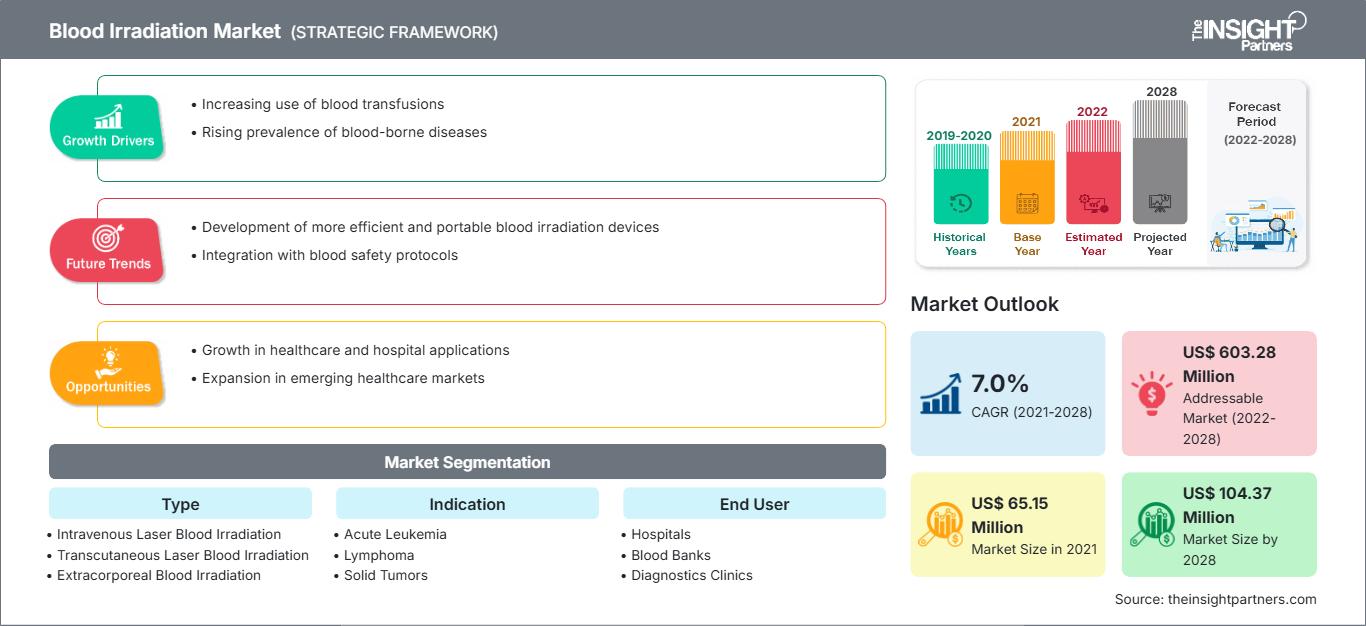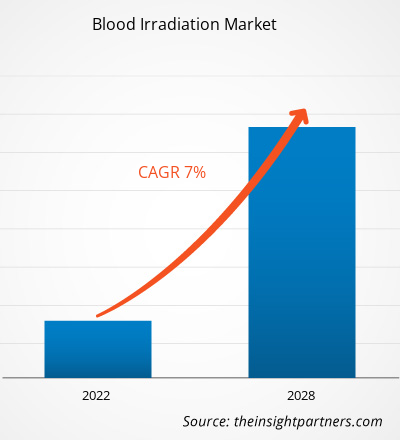Se prevé que el mercado de irradiación sanguínea alcance los 104,37 millones de dólares estadounidenses en 2028, frente a los 65,15 millones de dólares estadounidenses en 2021; se espera que crezca a una tasa de crecimiento anual compuesta (TCAC) del 7,0% entre 2022 y 2028.
El aumento de la prevalencia de enfermedades transmisibles y no transmisibles, junto con el incremento de la investigación y el desarrollo, impulsan el crecimiento del mercado. Sin embargo, el elevado coste de la irradiación sanguínea lo limita.
La irradiación sanguínea se logra exponiendo la sangre a al menos 25 Gy (2500 cGy) de radiación en el centro del vaso, lo que impide la replicación y el injerto de leucocitos T inmunocompetentes del donante en el receptor. La enfermedad de injerto contra huésped (EICH) causada por trasplantes de donantes es casi siempre mortal, por lo que los pacientes en riesgo deben recibir hemoderivados irradiados en la medida en que el tiempo y los recursos lo permitan. Las indicaciones clínicas, que incluyen leucemia aguda, linfoma, tumores sólidos que reciben quimioterapia o radioterapia intensiva, exanguinotransfusiones, receptores de trasplantes de órganos y bebés prematuros, requieren terapia de irradiación sanguínea. Los pacientes afectados por el virus de la inmunodeficiencia humana/síndrome de inmunodeficiencia adquirida (VIH/SIDA) no requieren irradiación de hemoderivados, ya que no se ha informado que sean susceptibles a la EICH postransfusional.
Obtendrá personalización gratuita de cualquier informe, incluyendo partes de este informe, análisis a nivel de país y paquetes de datos de Excel. Además, podrá aprovechar excelentes ofertas y descuentos para empresas emergentes y universidades.
Mercado de irradiación sanguínea: Perspectivas estratégicas

-
Obtenga las principales tendencias clave del mercado que se describen en este informe.Esta muestra GRATUITA incluirá análisis de datos, que abarcarán desde tendencias de mercado hasta estimaciones y pronósticos.
Perspectivas del mercado
El aumento de la prevalencia de enfermedades transmisibles y no transmisibles impulsa el crecimiento del mercado.
Se observa un aumento en la incidencia de enfermedades transmisibles y no transmisibles, como el cáncer, las enfermedades cardiovasculares, la enfermedad renal crónica y los accidentes cerebrovasculares, debido a la gran cantidad de personas susceptibles a estas afecciones en todo el mundo. Según la Organización Mundial de la Salud (OMS), las enfermedades cardiovasculares son la principal causa de muerte a nivel mundial, con aproximadamente 17,9 millones de fallecimientos anuales. Además, la creciente prevalencia de enfermedades transmisibles, como la hepatitis, la gripe, el virus de la inmunodeficiencia humana (VIH) y el síndrome de inmunodeficiencia adquirida (SIDA), está impulsando el crecimiento del mercado de la irradiación sanguínea. Según la OMS, en 2020, 325 millones de personas estaban infectadas con el virus de la hepatitis B, y 900 000 personas mueren cada año a causa de esta infección. Asimismo, el envejecimiento de la población mundial contribuye a la prevalencia de enfermedades no transmisibles, como las enfermedades cardiovasculares, las enfermedades renales y los accidentes cerebrovasculares. Según la OMS, la población de personas de 60 años o más era de 1.000 millones en 2019 y se espera que aumente a 1.400 millones en 2030 y a 2.100 millones en 2050. La población anciana es susceptible a enfermedades no transmisibles debido a diversos factores como la mala nutrición, la falta de actividad física, el consumo excesivo de tabaco y el consumo de alcohol.
Además, el aumento de las transfusiones sanguíneas debido al incremento de las intervenciones quirúrgicas, los accidentes, los traumatismos y las enfermedades, junto con la creciente prevalencia de infecciones del torrente sanguíneo, impulsa el crecimiento del mercado. Las infecciones del torrente sanguíneo, las enfermedades subyacentes y los procedimientos invasivos son frecuentes en la población geriátrica. Estas infecciones constituyen la principal causa de enfermedad y muerte en grandes poblaciones. Según la Biblioteca Nacional de Medicina, se producen aproximadamente 28 000 infecciones del torrente sanguíneo al año en todo el mundo. Asimismo, la creciente concienciación sobre las infecciones del torrente sanguíneo y el aumento de la respuesta inmunitaria a las transfusiones pueden provocar complicaciones, ya que el uso cada vez mayor de sangre irradiada en el tratamiento del cáncer fortalece el sistema inmunitario y mejora la salud general de los pacientes, lo que impulsa el crecimiento del mercado de la irradiación sanguínea.
Así pues, el aumento de la prevalencia de enfermedades transmisibles y no transmisibles, el incremento de las transfusiones sanguíneas, el aumento de las infecciones del torrente sanguíneo y el incremento de las respuestas inmunitarias están impulsando el crecimiento del mercado de la irradiación sanguínea.
Perspectivas basadas en tipos
El mercado de irradiación sanguínea, según su tipo, se segmenta en irradiación sanguínea láser intravenosa, irradiación sanguínea láser transcutánea e irradiación sanguínea extracorpórea. En 2021, el segmento de irradiación sanguínea láser intravenosa representó la mayor cuota de mercado. Sin embargo, se prevé que el segmento de irradiación sanguínea láser extracorpórea registre la mayor tasa de crecimiento anual compuesto (TCAC) del 7,8 % durante el período de pronóstico.
Información basada en el usuario final
Según el usuario final, el mercado de irradiación sanguínea se segmenta en hospitales, bancos de sangre, clínicas de diagnóstico e institutos de investigación. El segmento de hospitales ostentó la mayor cuota de mercado en 2021. Sin embargo, se estima que el segmento de bancos de sangre registrará la mayor tasa de crecimiento anual compuesto (TCAC) del 7,7 % durante el período de previsión.
Perspectivas regionales del mercado de irradiación sanguínea
Los analistas de The Insight Partners han explicado en detalle las tendencias regionales y los factores que influyen en el mercado de la irradiación sanguínea durante el período de previsión. Esta sección también analiza los segmentos del mercado de la irradiación sanguínea y su distribución geográfica en Norteamérica, Europa, Asia Pacífico, Oriente Medio y África, y Sudamérica y Centroamérica.
Alcance del informe de mercado sobre irradiación sanguínea
| Atributo del informe | Detalles |
|---|---|
| Tamaño del mercado en 2021 | 65,15 millones de dólares estadounidenses |
| Tamaño del mercado para 2028 | 104,37 millones de dólares estadounidenses |
| Tasa de crecimiento anual compuesto global (2021 - 2028)CAGR (2021 - 2028) | 7,0% |
| Datos históricos | 2019-2020 |
| Período de pronóstico | 2022-2028 |
| Segmentos cubiertos |
Por tipo
|
| Regiones y países cubiertos |
América del norte
|
| Líderes del mercado y perfiles de empresas clave |
|
Densidad de los actores del mercado de la irradiación sanguínea: comprensión de su impacto en la dinámica empresarial
El mercado de la irradiación sanguínea está creciendo rápidamente, impulsado por la creciente demanda de los usuarios finales debido a factores como la evolución de las preferencias de los consumidores, los avances tecnológicos y una mayor conciencia de los beneficios del producto. A medida que aumenta la demanda, las empresas amplían su oferta, innovan para satisfacer las necesidades de los consumidores y aprovechan las nuevas tendencias, lo que impulsa aún más el crecimiento del mercado.

- Obtenga una visión general de los principales actores del mercado de irradiación sanguínea.
Información basada en indicaciones
El mercado de la irradiación sanguínea se segmenta en leucemia aguda, tumores sólidos, tumores pélvicos, linfoma y otros. El segmento de leucemia aguda ostentó la mayor cuota de mercado en 2021. Sin embargo, se estima que el segmento de linfoma registrará la mayor tasa de crecimiento anual compuesto (TCAC) del 8,8 % durante el período de pronóstico.
Las empresas que operan en el mercado de la irradiación sanguínea adoptan la estrategia de innovación de productos para satisfacer las cambiantes demandas de los clientes en todo el mundo, lo que también les permite mantener su prestigio de marca a nivel global. Por ejemplo, en junio de 2021, Rad Source Technologies, proveedor estadounidense de productos comerciales de radiación de rayos X, diseñó un producto para reemplazar los irradiadores gamma autoblindados y presentó su nuevo irradiador sanguíneo RS 3400 rediseñado en MEDLAB Middle East 2021.
Mercado de irradiación sanguínea – por geografía
Geográficamente, el mercado de irradiación sanguínea se segmenta en Norteamérica (EE. UU., Canadá y México), Europa (Francia, Alemania, Reino Unido, España, Italia y el resto de Europa), Asia Pacífico (China, India, Japón, Australia, Corea del Sur y el resto de Asia Pacífico), Oriente Medio y África (Arabia Saudita, Emiratos Árabes Unidos, Sudáfrica y el resto de Oriente Medio y África) y Sudamérica y Centroamérica (Brasil, Argentina y el resto de Sudamérica y Centroamérica). Entre los participantes del mercado incluidos en el estudio se encuentran Typenex Medical, LLC; Hitachi Medical Systems; Rad Source Technologies; Gilardoni SpA; Gamma-Service Medical GmbH; Actemium; y Best Theratronics Ltd.
- Análisis histórico (2 años), año base, pronóstico (7 años) con CAGR
- Análisis PEST y FODA
- Tamaño del mercado, valor/volumen: global, regional y nacional
- Industria y panorama competitivo
- Conjunto de datos de Excel
Informes recientes
Informes relacionados
Testimonios
Razón para comprar
- Toma de decisiones informada
- Comprensión de la dinámica del mercado
- Análisis competitivo
- Información sobre clientes
- Pronósticos del mercado
- Mitigación de riesgos
- Planificación estratégica
- Justificación de la inversión
- Identificación de mercados emergentes
- Mejora de las estrategias de marketing
- Impulso de la eficiencia operativa
- Alineación con las tendencias regulatorias






















 Obtenga una muestra gratuita para - Mercado de irradiación sanguínea
Obtenga una muestra gratuita para - Mercado de irradiación sanguínea